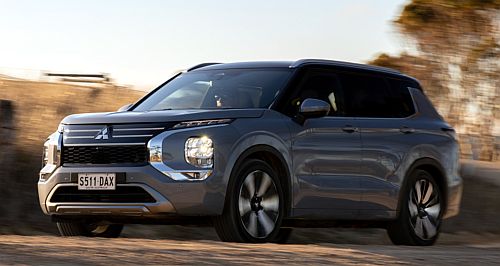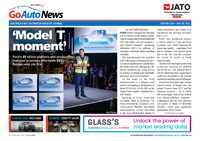Make / Model Search
News - MitsubishiMitsubishi wants PHEV incentives reinstatedDiscontinuation of FBT waiver for PHEVs was a “serious mistake”: MMAL chief executive8 Jul 2025 By TOM BAKER MITSUBISHI Motors Australia Limited (MMAL) is expected to place a greater emphasis on hybrid powertrains in the coming years, with a focus on plug-in hybrid electric vehicles (PHEVs) a key component of its strategy to meet federal New Vehicle Emissions Standard (NVES) demands.
Speaking to GoAuto at the launch of the facelifted Outlander midsize SUV, MMAL chief executive officer Shaun Westcott said Mitsubishi regards PHEV technology as suitable for Australian customers while also satisfying regulatory demands.
“We believe the correct transition technology is PHEV,” Mr Westcott said. “Even when (a PHEV has a dead battery) it is not running as a (pure) internal combustion engine (ICE)—it is running as a hybrid EV (HEV), and you still have significant fuel and emissions reductions.”
MMAL continues to be frustrated by the federal government’s decision to axe the main PHEV purchase incentive, being a full waiver of fringe benefits tax (FBT) for operators under novated leases, from 1 April 2025 while the FBT waiver continues unchanged for leases of battery electric vehicles (BEVs).
The discontinuation of the FBT waiver for PHEVs came as a blow to sales of the Mitsubishi Outlander PHEV in Australia, which climbed to a 34 per cent share of Outlander sales in the final months of the incentive’s applicability and have since crashed to just under 10 per cent, exacerbated by a facelift changeover.
Every sale of a HEV or PHEV, typified by their low official CO2 emissions, enhances MMAL’s position in relation to financial penalties for breaching NVES CO2 limits, which tighten from 141g/km in 2025 to 58g/km in 2029 for cars and SUVs. Higher limits apply to utes and 4WDs, affecting Triton.
Mr Westcott told GoAuto he believed the FBT waiver for PHEVs should be immediately reinstated, reflecting the substantial contribution of PHEVs to actual emissions reductions from private vehicles.
“Stopping the FBT exemption on PHEVs was a serious mistake,” Mr Westcott told GoAuto. “I have been outspoken and have offended a few politicians. Look at what (the FBT exemption) did. It worked. If we had a few more carrots, it will work. Let’s do it—what are we waiting for?”
The discontinuation of the FBT exemption for PHEVs was based on a compromise struck in the Albanese government’s first term between Labor and the Greens in which the latter party supported federal EV incentive legislation on the condition PHEVs, which continue to rely on ICE engines, would eventually be excluded.
Mr Westcott strongly disputed that logic based on electric driving data he claimed MMAL has sourced from existing Outlander PHEVs on the road in Australia.
“We can get (this) data from our cars. We have been selling PHEVs in Australia since 2017. Our customers use their PHEV in pure EV mode (an average of) 83 per cent of the time.
“Our (PHEV) customers have reduced emissions by 83 per cent right here, right now, today, with zero investment in infrastructure—but if I want to do that trip to Melbourne, I don’t have to worry about it,” Mr Westcott said.
It is not known whether the data on Outlander PHEV electric mode use has been sourced from a wide group of customer-owned vehicles or MMAL’s own internal fleet of Outlander hybrids.
In late 2026, MMAL will launch its first BEV since the tiny i-MiEV (2010-2012), and the electric (manufactured by Taiwanese conglomerate Foxconn) will qualify for the FBT exemption incentive—but Mitsubishi’s key NVES bulwark will continue to come in the form of petrol-electric hybrid SUVs.
Coming soon is a second-generation ASX—a rebadged Renault Captur, and globally available with low-CO2 HEV and PHEV powertrains—while MMAL is understood to be considering importing the new Grandis: no longer a minivan, but instead an Eclipse Cross replacement globally built with hybrid engines.
MMAL already offers the Outlander midsize SUV, offering a cheaper but higher-CO2 135kW/244Nm non-hybrid petrol (170-175g/km CO2) or a more expensive, overperforming PHEV which in facelifted form will make around 222kW, run for 86km (WLTP) on battery power, and produce about 30g/km CO2.
MMAL executives would not be drawn on where the ongoing share of Outlander PHEV sales will ‘normalise’ to in comparison to the cheaper, non-hybrid petrol, though it is expected to be higher than the current “just under 10 per cent” rate which is being distorted by the facelift changeover.
Until recently Mitsubishi also marketed the smaller Eclipse Cross SUV with a PHEV option, but that model has been discontinued (along with the ASX and Eclipse Cross) due to a decision not to re-engineer that trio for uprated autonomous emergency braking standards under Australian Design Rule 98/00.  Read more |
Click to shareMitsubishi articlesResearch Mitsubishi Motor industry news |











Facebook Twitter Instagram